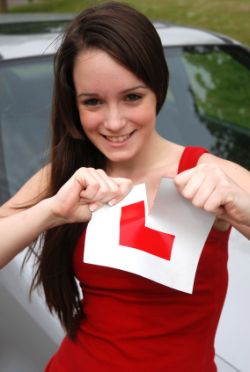Hazard Perception
There has been a significant increase in the focus of hazard perception and hazard awareness in the last few years since the introduction by the DSA of a separate hazard perception element to the theory test.
Hazard perception requires you to always be thinking of, looking out for and being aware of potential hazards so that you can react in good time should that hazard develop from a potential into a real hazard.
For instance, if there is a cyclist on the pavement, then they may not currently be a hazard but you should be aware that they could swerve out into the road and become an actual hazard. Often the lines are a little blurred and it is a matter of interpretation but as a general rule of thumb, anything that could potentially be dangerous to you or anyone else is a potential hazard that then can develop into an actual hazard.
There are a large range of different hazards. If a police car is coming up behind you with lights flashing attending an emergency, then that is a hazard situation. Some hazards are more clear cut than others: clearly a driver going the wrong way is a very real and dangerous hazard. Where two different sections of road join and one driver pulls dangerously in front of the other is of course also a hazard situation.
If a pedestrian or other road user behaves erratically, swerves or drives too closely to you, then this is also a hazard. The key to hazard perception is always be alert to what is happening and what other road users are doing. If you spot debris in the road well ahead of where it is for instance, then you can mitigate that hazard by reacting in good time, rather than not paying attention to the road and having to take a potentially dangerous manoueuvre to avoid it at the last minute.
So it can be seen that related to hazard perception are the skills of alertness, safety margins, attitude, knowledge of road and traffic signs and the rules of the road.
You can practice hazard perception by testing your awareness against our video clips.
Related Articles...
What to do in an accident situation
If you do have an accident, then you must stop. Whilst you may read about people driving away from the scene of an accident, you should always stop and face up to any responsibilities involving...
Your driving licence: getting it back
As the New Drivers Act article outlines, if you get six penalty points or more in the first two years of having a licence, then it is revoked and you have to retake both tests: the theory and the...
Why new drivers are more likely to be involved in an accident
It is a well known statistic that new drivers are more likely to be involved in accidents, and indeed insurance companies definitely know this as you'll see by comparing premiums as a new driver...
Mock Driving Theory Test
Many learner drivers are in the process of finishing A-levels or at university, and so the process of exams and tests is very familiar to you. For those that tests and exams are a distant memory, a...
What is driving test theory?
Theory is something we understand when it comes to maths or science. A theory is a prediction as to why something that has usually been observed to happen does happen, and scientists use theories...
Professional driving instructors
When you learn to drive, you have the choice who teaches you. The majority of people decide to learn through a professional driving instructor and often through a major school of...
What to do at level crossings
When you are learning to drive you may well not come across a level crossing, depending where you live. But as a driver you certainly will come across level crossings and will need to know how to...
What to look for when you see a vehicle
Here is a simple check list of things to take into account when you check a used vehicle that you are considering purchasing.
Firstly, look at the engine carefully, and see if you think it has...
Prepare for driving theory tests
In order to pass tests, whether they are academic tests at school such as english, geography, spanish, french and so on, or to pass some other one - like theory tests - the methodology that can be...
What to do if you breakdown at a level crossing
Driving is potentially dangerous, but it is important not to worry about things that could happen when driving but at the same time you should know what to do in the unlikely event that something...
Back to home page of driving theory test questions

